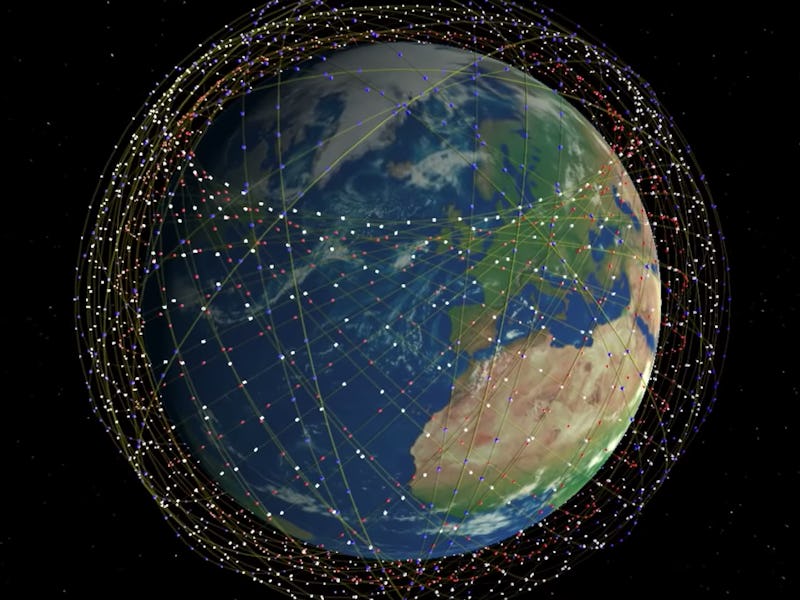Starlink: How SpaceX’s satellite constellation could help build a Mars city
A new report sheds light on how the constellation could be a make-or-break moment.

Can SpaceX foot the bill for a future Mars city? Starlink, its internet constellation plan, could provide the answer.
A report from Morgan Stanley Research suggests the constellation is a make-or-break moment for SpaceX. The report, shared with Business Insider on Tuesday, gives the privately-held company a base valuation of $52 billion, more than 50 percent higher than the $33.3 billion valuation revealed by CNBC in May. It’s also more than publicly-traded Tesla, which at the time of writing has a market cap of $43.7 billion.
What comes next could decide SpaceX’s future valuation. Starlink is designed to beam internet down to practically anywhere that can look to the sky, with low latency and high speeds. The $52 billion figure assumes that broadband internet penetration will move from 50 percent of the global population today to 75 percent in the future, as expanding access brings more people online. The figure assumes SpaceX captures around 10 percent of this emerging market.
If SpaceX is far more successful with Starlink than expected, the analysts predict the company could actually be worth $120 billion. If it’s a failure, the company could collapse to a valuation of just $5 billion.
Starlink could be the project that propels SpaceX to newfound valuations, or it could be the beginning of its downfall. If the constellation succeeds in its goals, it could pave the way for SpaceX to start building out its city on Mars by 2050.
A Mars city.
SpaceX: How the company plans to build a city on Mars
SpaceX is currently building the Starship, a resuable rocket designed to send people to Mars and beyond. It uses liquid oxygen and methane as the fuel for its Raptor engines, which means astronauts can set up propellant depots and harvest the materials to return home on Mars. It can carry up to 100 people at once in a pressurized cabin around the size of an Airbus A380.
The firm completed a 150-meter hop with a shortened version of the ship section in August. CEO Elon Musk is scheduled to host an event on September 28, the anniversary of SpaceX first reaching orbit, to discuss the next steps. An orbital flight with a full-size prototype ship could happen as early as October. From there, the Starship is expected to host a satellite launch in 2021 and a manned trip around the moon in 2023.
The city on Mars, which would start as a small settlement and gradually expand out, is expected to cost a lot of money. Even beyond the price of actually developing the Starship, Musk has claimed that developing a city on Mars would cost between $100 billion and $10 trillion. That’s based on transporting one million tons of cargo, with each ton costing $100,000 to send to Mars.
Last month, during a conversation with Alibaba co-founder Jack Ma on stage in Shaghai, Musk put it a different way. The figure equates to somewhere between half a percent and one percent of gross domestic product, somewhere between the amount spent on cosmetics and healthcare.
“It seems like a wise investment for the future,” Musk said.
Starlink in action.
SpaceX: How Starlink could fund the city of the future
No matter how you cut it, Musk is still asking for an astronomical figure. The entire satellite launching industry, SpaceX’s main business, only brings in around $5 billion in revenue per year.
Starlink is ambitious, but it could provide the answer. The entire system is expected to cover around 12,000 satellites when complete, vastly eclipsing the approximately 5,000 crafts orbiting the Earth in total right now. SpaceX launched the first 60 satellites in May 2019.
As Morgan Stanley notes, a constellation like this could provide internet access for more people than ever. In documents shared by the Wall Street Journal in 2017, the company predicts that Starlink could have over 40 million subscribers and supply over $30 billion in revenue by 2025. The company’s total revenue that year could reach over $35 billion.
It could go even higher. Musk told reporters in May that the total global internet connectivity revenue is somewhere around $1 trillion. He claimed that SpaceX could maybe access around three percent of that, or possibly even five percent. That means Starlink revenue alone could reach $50 billion annually, half the required figure for Musk’s low-end estimate to build a city on Mars.
“We think this is a key stepping stone towards establishing a self-sustaining city on Mars and a base on the moon,” Musk said in the call. “We believe we can use the revenue from Starlink to fund Starship.”
The success of Starlink could dictate the future success of a self-sustaining city on Mars, and decide whether this is the moment when humans establish a permanent settlement on another planet.